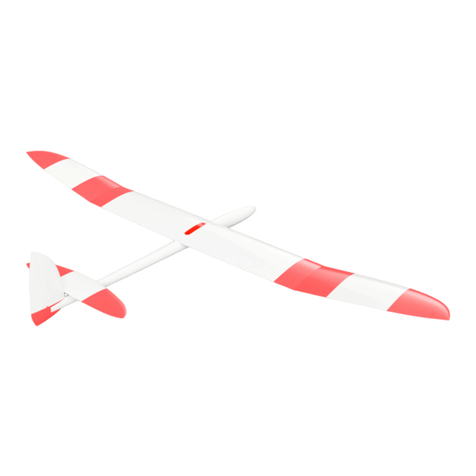
To assemble the wings, 2 carbon rods with a 4mm diameter are required (465mm for
Floaterwing and 360mm for Acrowing). The assembly is explained here using the example
of the floater wing, but works in exactly the same way for acrowing.
First insert the carbon rod into the Wingjoiner and carefully assemble one wing half without
glue. Check immediately whether the recess for the carbon rod is free, the manufacturing
process may cause small impurities to be present. This must be carefully pierced with the
rod. To do this, carefully twist and push the rod back and forth until the channel is free - but
be careful! The fit of the Wingjoiner in the Wingcenter should also be checked before
bonding and, if necessary, sanded down for a snug fit.
When everything fits, the carbon rod
can be inserted into the Wingjoiner and
the WingcenterL glued to the
Wingjoiner - it is best to use thick
superglue and apply it generously! Now
the wing can be glued part by part on
both sides, always making sure that the
surface segments are flush.
After the wings have been glued, they
can be screwed to the corresponding
Wingadaptermount
(„Flächenaufnahme) (attention - as with
the "Wingjoiner" part, there is also a
part for the floater and a part for the
acrowing).
To do this, insert an M6 hexagon nut into the recess provided in the Wingadaptermount
and fix the wing from above with an M6 plastic screw. After the adapter and wing are
connected, the fit between the fuselage and wing can be tested and, if necessary, sanded.
The 2 tabs of the Adaptermount should slide into the corresponding recesses in the
fuselage with light pressure and then be secured with 2 carbon rods (4mm diameter). The
locking pins should have a snug fit with enough friction not to loosen in flight. Alternatively,
other types of security can also be used.
Last but not least, the parts cockpit, canopy, motorspant and Fus1 or motor nose are
beeing assembled as seen in the explosion view. To glue the canopy and cockpit at the
right angle, the fuselage itself can be used as a template - apply glue, position the parts
with the help of the fuselage and use the activator. 4 round magnets 10x4mm are used to

























